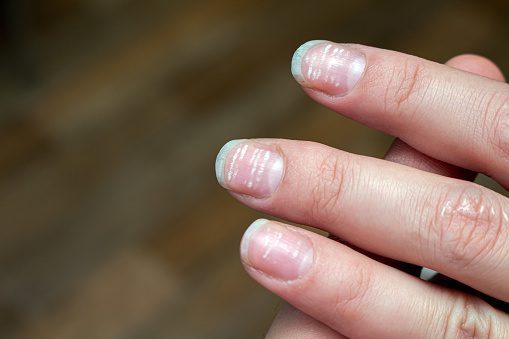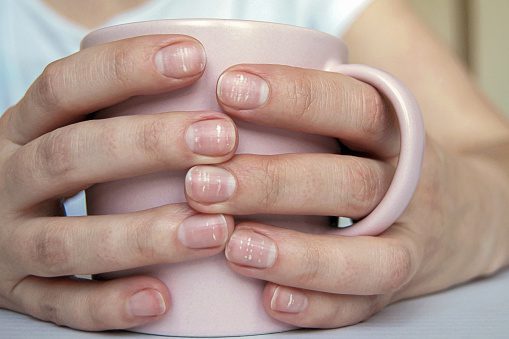Have you ever spotted tiny white marks on your fingernails and thought, “Ah, I must be low on calcium”? You’re definitely not alone. For years, we’ve been told these mysterious specks are the telltale signs of nail plate calcium deficiency, but is there any truth to it?
Alerta de spoiler: não é verdade.
Let’s break it all down and uncover what your nails are actually trying to tell you, without jumping to conclusions about your milk intake.



A deficiência de cálcio na placa ungueal é um fato real?
First things first, let’s talk about what the nail plate actually is. Your nails are made of queratina, a strong protein also found in your hair and skin. They grow out from the nail matrix, the area beneath the base of your nail, and gradually harden as they push forward.
A verdade é que esses minúsculos pontos brancos, chamados de "pontos parciais", são muito mais difíceis de serem identificados. leuconíquia, are caused by minor trauma to the nail matrix. While those little nail plate cells are travelling from the nail matrix and through the eponychium where the cuticle is attached before those nail plates appear from under the Proximal Nail Fold, they are going through a transformation process. Sometimes, something like an aggressive manicure could possibly cause the problem. Still, according to medical science, it happens when the nail plate cells are supposed to compress and become transparent but (for some reason) they don’t and remain as little, opaque, unfinished nail plate cells.
Seja qual for o caso, algo interfere na forma como as células da unha se formam, deixando para trás uma pequena área opaca que se torna visível semanas depois.
Portanto, não, suas manchas brancas não estão pedindo um suplemento de cálcio.
O que são manchas brancas na placa ungueal e quais são suas causas?
White spots within the nail plate, often referred to as partial leukonychia, are usually caused by minor injury to the nail matrix beneath o eponíquio. When the matrix is disrupted, some nail cells may be pushed out before they are fully developed. These immature cells appear as pale or white spots as they grow with the nail. Once the injury heals, the nail matrix produces normal cells again. Larger clusters of these underdeveloped cells can create a soft area in the nail, so extra care should be taken when preparing the nail plate for artificial nail products. To be sure you are looking at partial leukonychia, apply a little pressure on the nail plate, and if that white spot remains white, then you are; if the color changes it’s something else.
Mudanças nas unhas e o que elas significam Fazer Média
Although calcium isn’t to blame, your nails can still reflect aspects of your health. The key is to know what kinds of changes matter and which ones are just surface-level quirks.
Here’s a quick cheat sheet:
- Manchas brancas: Geralmente é resultado de um defeito no processo de compressão ou de um trauma leve no eponíquio ou ao redor dele, e não de deficiências nutricionais.
- Cumes: As cristas verticais são comuns com a idade. Sulcos horizontais profundos (Beau’s lines) pode indicar uma doença passada, um choque ou até mesmo um momento de estresse terrível.
- Suave ou unhas quebradiças: Often due to excessive water exposure, frequent handwashing, or harsh nail prep techniques, rather than diet.
- Amarelamento: Isso pode ser devido a esmalte tradicional., psoriasis, alopecia, lichen planus or a infecção fúngica.
A conclusão a que se chega aqui é que nem todas as alterações nas unhas estão relacionadas à nutrição e muito menos à deficiência de cálcio na placa ungueal.
The Truth About Calcium’s Role in Nail Plate Health
Para ser justo, o cálcio tem um pequeno papel de apoio na saúde geral das unhas. Ele contribui para a estrutura das células, e uma deficiência extrema a longo prazo pode afetar a qualidade dos tecidos em crescimento, inclusive das unhas. Mas isso é raro na maioria dos indivíduos bem nutridos.
A deficiência de cálcio tende a se manifestar em sistemas mais críticos, como ossos e dentes.
If you’re consuming enough calcium through your diet, such as from dairy, leafy greens, almonds or fortified plant milks, you’re more than likely meeting your body’s needs.
E se suas unhas estiverem fracas ou escamosas, o culpado provavelmente é mais externo do que interno. Há mais dois fatores aqui:
- If you have a short nail matrix you will have thin nails.
- If you file the nail plate too aggressively during nail prep, you will damage the essential structure of the nail plate needed to maintain its strength and flexibility, causing excessive nail weakness and creating even more flaking & delamination.
Mitos comuns sobre a deficiência de cálcio na placa ungueal
It’s easy to get caught up in old wives’ tales and internet wellness tips, so let’s clear up a few more common myths.
- Myth: Biotin and calcium supplements will fix all nail issues.
Truth: They might help if you have a diagnosed deficiency, but most people won’t see dramatic improvements unless there’s an actual imbalance. - Mito: Beber mais leite fortalecerá suas unhas.
Truth: While milk is a source of calcium, your nails aren’t thirsty for it in the same way your bones are. Your nails do love nail oil, but drinking it will not help. Rub it in gently after applying it behind the free edge of the nail plate, allowing it to run into your lateral nail folds. The warmth created by rubbing will help the oil penetrate your nail plate. - Mito: Todos os problemas nas unhas significam que há algo errado com sua dieta.
Truth: More often, it’s your daily habits, such as biting, picking, washing, or harsh nail prep treatments, that are to blame. - Mito: Lixar a borda livre da lâmina ungueal em uma direção impedirá que ela se parta.
Truth: A 120grit diamond nail file will tear up the free edge of the nail plate regardless of which way you file it. It’s better to use 180-240 grit file applying gentle, even pressure to avoid this happening.
Como cuidar de fato de sua placa ungueal
Em vez de perseguir o mito da deficiência de cálcio na placa ungueal, concentre-se nesses hábitos reais de cuidados com as unhas.
Hidratar, hidratar, hidratar: Use óleos de alta qualidade para unhas e pele em combinação com cremes para as mãos ou esfoliantes de alta qualidade regularmente para evitar que as unhas e a pele ressequem e descasquem.
- Proteja suas mãos: Use luvas ao limpar ou lavar pratos para evitar superexposição à água e produtos químicos.
- Arquivar corretamente: Use uma lixa de grão 180-240 ao lixar a borda livre para evitar danos adicionais.
- Don’t pick or bite: It may be a nervous habit, but it’s also one of the quickest ways to damage the nail plate and surrounding skin.
- Tenha uma dieta balanceada: Inclua bastante proteína, ômega-3 e ferro, zincoO objetivo da dieta é ajudar as unhas de dentro para fora. A matriz da unha obtém seus nutrientes do sangue e somente do sangue; quanto melhor for sua dieta, melhores serão suas unhas.
Considerações finais sobre a deficiência de cálcio na placa ungueal
While it’s tempting to blame white spots or brittle tips on a nail plate calcium deficiency, the science just doesn’t back it up. More often than not, your nails are reacting to the everyday wear and tear they go through. Whether that’s a knock on the table, frequent handwashing, or a particularly aggressive manicure, these things have more of an impact than a glass of milk ever could.
So the next time someone points to your nail and says, “You need more calcium,” feel free to drop a little knowledge. Your nails are complex, yes, but they’re also surprisingly resilient. With the right care and a bit of myth-busting, they’ll stay strong and healthy without needing a trip to the dairy aisle.
Leitura adicional
Think those white spots on your nails mean you need more calcium? Not quite! While it’s a common myth, the truth behind those marks is more complex. Learn what actually causes white spots and lines on nails in our in-depth guide on leuconíquiaO que é, por que acontece e o que realmente significa para a saúde das unhas. Leia mais aqui.


